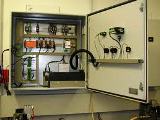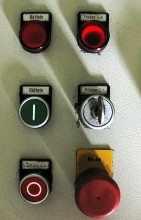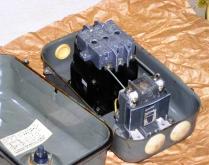Protection against undervoltage in the circuits of machines, equipment and machines
 Overvoltage protection excludes the possibility of self-starting the electric motor or its operation at a sharply reduced mains voltage. This protection is sometimes called null protection.
Overvoltage protection excludes the possibility of self-starting the electric motor or its operation at a sharply reduced mains voltage. This protection is sometimes called null protection.
In DC motors with parallel excitation and asynchronous motors, with a decrease in voltage, the magnetic flux and the torque proportional to it decrease, which leads to overloading of the motor and its overheating. This will shorten the life of the engine and may cause engine damage. In addition, when operating at reduced voltage, the motor, consuming increased current, increases the voltage drop in the network and worsens the performance of other consumers.

Overvoltage protection (zero protection) is performed in the control circuits of contactor-relay motors linear contactors, electromagnetic starters or special undervoltage relays.
For example in remote control circuits with start and stop buttons when powering control circuits and main circuits from a common source, undervoltage protection is provided by an electromagnetic starter. In crane motor control circuits — linear contactor.
The release voltage of starters and contactors is about 40 — 50% of the nominal voltage of the coil, therefore, with a significant decrease or complete loss of voltage in the network, the starter or contactor drops out, disconnecting the motor from the network with the main contacts.

In an automatic control scheme where the motor starters are not switched on by buttons but various automation elementswhen operating without operator intervention, undervoltage protection is provided by a special undervoltage relay. When the voltage drops or disappears, the undervoltage relay trips, breaking the circuits and thus shutting down all devices on the control circuit.
If you give commands implemented by a command controller or by a control switch with fixed positions of the handle, undervoltage protection is also provided by a special relay, the coil of which is turned on by the open contact of the controller, closed only when the handle is in the zero position and open in all other positions. Contacts of all types protections operating in the complete shutdown of the installation are connected in series to the winding circuit of the undervoltage relay.
Undervoltage protection can be carried out by automatic switches (automatic devices) with low voltage release, allowing the machine to be switched on when the mains voltage is not lower than 80% of the nominal and automatically turning off the switched-on machine when the voltage disappears or when drop to 50% of par.
The low-voltage release can be used to remotely shut down the machine, which requires the opening of a push-button contact or other device in the coil circuit.Some machines are made with a special brake coil that shuts down the machine when energized.
See also: Minimum and maximum voltage protection in relay protection and automation
